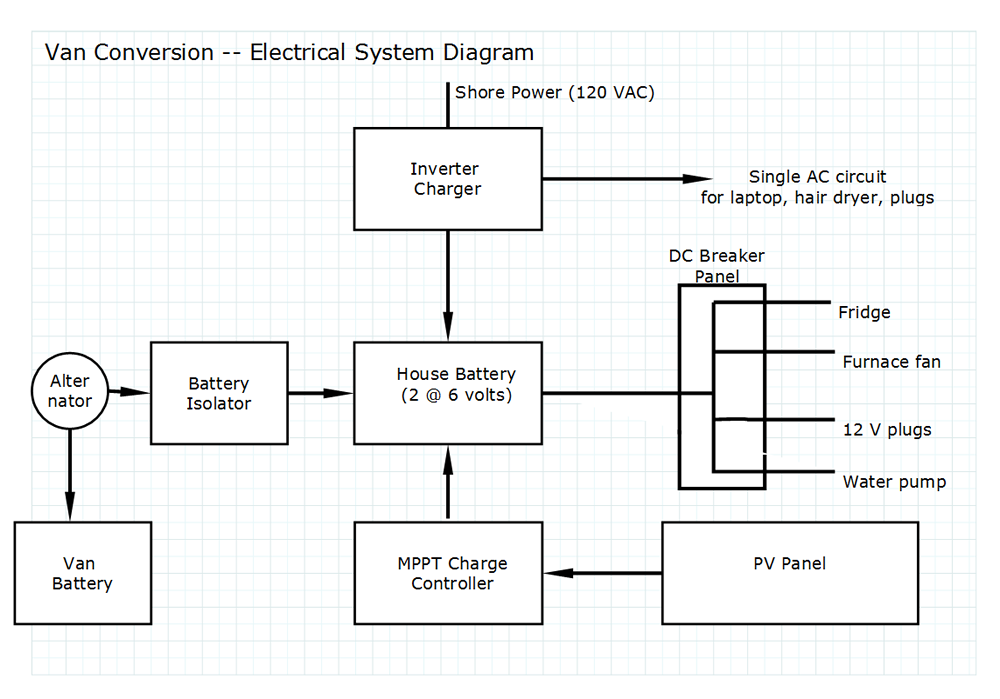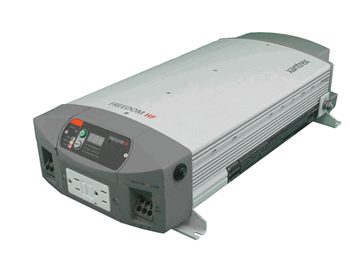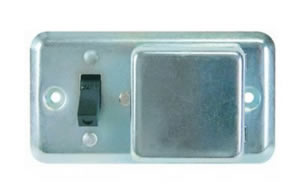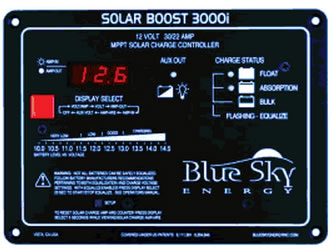
Search
The Renewable Energy site for Do-It-Yourselfers
ProMaster DIY Camper Van Conversion -- Electrical and Solar
|
Our aim for the electrical system is to be able to do without electrical hookups indefinitely, and to be able to be away from any power source for a day or two without much sun and without having to run the engine.
To achieve this we have tried to keep electrical loads down by choosing efficient gadgets, avoided some high power consumption electrical devices, included some extra battery capacity, and a solar panel to charge the battery when sun is available.
The electrical system is just at the planning stage at this point. I've not purchased any of the components yet. If you have any thoughts or suggestions, I'm all ears.
Back to the ProMaster camper van conversion main page...
|
|
Overview:
At the heart of the camper electrical system is the house battery. It can receive charge from three separate sources: 1) the van alternator when the engine is running, 2) the roof mounted solar panel, and 3) the inverter/charger when plugged in to shore power.
The house battery powers all of the DC loads (like fridge, furnace fan, water pump) via the DC distribution panel. It also powers one AC circuit through the inverter/charger.

Components:
These are the tentative choices for the main components. If you have some good alternatives, please let us know...
| Item |
Description |
Cost |
| House Battery |
2 @ 6 volt, 225 AH golf cart batteries (eg Trojan T105 or Costco equiv) |
$170 |
| Inverter/Charger |
Xantrex Freedom HF1000 w/20amp Charger |
$400 |
| Battery Isolator |
Install Bay IB200 200 amp Battery Isolator and Relay |
$45 |
| MPPT Charge Controller |
Blue Sky 3000i MPPT charge controller |
$264 |
| DC Distribution and Fuse Panel |
Blue Sea 5025 six circuit fuse DC distribution panel |
$32 |
| PV Panel |
eg Solar World SW250MONO 250 watt, 60 cell PV module |
$296 |
| |
|
|
| Total |
(not including fuses, wire, ...) |
$1207 |
| |
|
|
Batteries
The two 6 V - 225AH golf cart batteries is probably overkill, and I may yet go with the 12V-100+ AH deep cycle battery and just leave space for the two batteries if needed later. This would save about 60 lbs, but not much money as the 6 V golf cart batteries are a much in demand item with lower price.
I thought about using an AGM battery, but the extra cost does not seem worth it me -- I'm used to taking care of flooded batteries and don't mind adding another.
The batteries will live inside the van in a case that is sealed and vented to the outside.
DC Distribution and Fuse Panel
The DC distribution panel distributes the 12 volt battery power from the house batteries to each of the 12 volt loads in the van, and provides fuse protection for the wiring in each DC circuit.
This one from Blue Sea is looking pretty good to us...
For $32 it provides up to 6 DC circuits with a blade style (automotive) fuse for each circuit -- they also make panels that will accommodate more circuits.

It also is fairly compact for our limited space for electrical junk.
Battery Isolator
This gadget allows the van alternator to be used to charge the house battery, while preventing the van starting battery from being drained by power loads in the RV -- it isolates the van starting battery from the house battery so that RV loads only discharge the house battery. The idea is that even if you discharge the house battery overnight, the van starting battery will still be fully charged.
I'm a bit confused by the number and price range of these battery isolators -- everywhere for $15 for relay type, up to a couple hundred dollars for fancy electronic ones. Not clear to me what the fancier ones provide?
I'm leaning toward the relay type isolator and thinking about this one... from Install Bay.

Its the heavy duty end of the relay type isolators.
This kind of unit appeals to me in that it does not have the voltage drop that the diode based ones do, it does not get wired between the alternator and the starting battery as the diode ones do, it appears that it is easier to hook up because it just needs a wire from the starting battery and an 12V source that goes on with the ignition switch, its cheaper, and my past RV's have used this type of relay switcher with no problems.
Not sure if I'm reading this right, but it seems like when you start the van that this unit puts the starter battery in parallel with the house battery. I guess this could be good if your starting battery is low, but maybe not so good if your house battery is low?
Still a bit undecided on this, so if you have any thoughts, I'd like to hear them.
Inverter/Charger:
The inverter/charger performs two jobs. When you are not hooked up to shore power and are being powered by the house battery, it provides limited 120 volt AC power for the van from the house battery. When you are hooked up to shore power, it turns off the inverter function and passes the shore power through to the AC loads that are connected to the inverter, AND it charges the house battery using a full 3 stage charger.
The one we are thinking about is this one... from Xantrex.
Cost $400.

I like this kind of inverter/charger because: 1) it eliminates the need for a separate battery charger to charge from shore power, 2) it has 3 stage charging, so its easy on the battery, 3) it automatically switches from the inverter powering AC loads to the shore power when you plug into shore power, so you can hook your AC loads up to the inverter and they will be powered whether you are on shore power or on house battery power.
Like most of these inverters, it draws about 10 watts from the battery whenever the inverter is turned on even if nothing is plugged into the inverter, but it can easily be turned off manually when no AC power is being used, so this is a nuisance, but not a serious one. If you forget to turn it off when not in use, it would drain about 20 amp-hrs out of the battery in 24 hrs. Its also not a pure sine wave inverter, but I think this will be OK for our loads -- will see I guess.
If you are aware of a better choice, please let me know.
AC Distribution Panel:
In our case, this there is just one AC circuit that is powered off the inverter (or shore power via the inverter if plugged in). Just to keep things simple and compact, I'm thinking about using an AC fuse mounted in a junction box (as is typically installed next to a house furnace). This seems to be up to the job for just one circuit and avoids the expense and is much more compact that any AC circuit breaker box I could find.

The cover opens to reveal a standard Edison socket screw in fuse.
Charge Controller:
The charge controller sit between the PV panel and the house battery and allows the PV panel to efficiently charge the battery without over charging it.
We are liking this new Blue Sky 3000i charge controller...

This is a new MPPT charge controller that in addition to taking 12 volt 36 cell PV panels will also take a single large 60 cell about 30 volt PV panel. The 60 cell panels are very commonly available and fairly cheap. I like the idea of having just one PV panel to reduce wiring and make for a simpler arrangement on the roof. It will take up to a 290 watt PV panel.
Its an MPPT charger, so it charges somewhat more efficiently than the PWM ones.
It also includes a battery monitoring function and display that gives battery status and amp-hrs remaining -- this eliminates the need for a separate battery monitor and conserves space.
Cost $264.
PV Panel:
Planning to use a single fairly large panel -- probably a 60 cell panel.
For example from Platt Electric the SW250MONO 250 watt 60 cell panel at $296 -- pick up at the local Platt Electric.
Size: 66 by 37 inches.
Thinking about mounting it as low as possible and aft of the Fantastic Fan on the centerline of the roof. From a drag point of view it would be better to have a narrower panel (or maybe even two narrow panels mounted end to end along the centerline?).
Wire:
I'm planning to use regular Romex house wire for the wiring with some flex conduit for extra protection in areas where it looks like rubbing might occur.
The Romex appears to be very common in RV's and is cheap and easy to run.
Electrical Loads Estimate
I did a rough estimate of the power use while in camping mode, and estimated the battery size and PV panel size needed to support this load for a couple days.
I have assumed an 80% battery discharge level in these estimates. I know that batteries will last longer if only discharged to 50%, or even less, but if you look at the Trojan estimate for number of charge/discharge cycles for an 80% discharge, its about 750 cycles. For an RV that only gets used maybe 30 days a year, 750 cycles is about 25 years, and I'm sure the battery will die of something else before 25 years. Maybe I'm missing something?
The spreadsheet also includes a rough heat loss calculation to get the furnace size and the power drain for the furnace fan and electronics. This came out to about 3000 BTU/hr with 32F outside and 68F inside the van -- this is for an insulated small van.
If you have something that will view Excel Spreadsheets, download Excel Spreadsheet here...
Otherwise, table below is copied out of the spreadsheet, but its hard to read because of the formatting.
| Van Conversion -- Electrical loads Estimate |
|
|
|
|
|
|
|
|
|
|
|
|
|
|
| These are loads for one 24 hr period. |
|
|
|
|
|
|
|
|
|
|
|
|
|
|
|
|
|
|
|
|
|
|
|
|
|
|
|
|
|
|
| Available Power From Battery |
|
|
|
|
|
|
|
|
|
|
|
|
|
|
|
Battery size (amp-hr at 12V) |
discharge depth |
voltage |
Energy avail (wh) |
|
|
|
|
|
|
|
|
|
|
|
100 |
0.8 |
12 |
960 |
Trojan SCS150 RV/Marine battery: 100 ah, 11.3 L X 6.7 W X 9.8 D |
|
|
|
|
|
200 |
0.8 |
2 @ 6
|
1920 |
This could be two of the Trojan 6V golf cart bats (or two Costco golf cart bats). |
|
|
|
| Might want to just leave space provisions for the 2nd battery. |
|
|
|
|
|
|
|
|
|
|
|
|
|
|
|
|
|
|
|
|
|
|
|
|
|
|
|
|
|
|
|
|
|
|
|
|
|
|
|
|
|
|
|
|
|
| Assumed below that things that are on all the time (CO detector, fridge) will run off the battery for 16 hours -- that engine running or solar will take care of the rest) |
|
|
|
|
|
|
|
|
|
|
|
|
|
|
|
|
|
|
|
|
|
|
|
|
|
|
|
|
|
|
|
|
|
|
|
|
| Solar Panel: |
|
|
|
|
|
|
|
|
|
|
|
|
|
|
|
| Based on the stuff below, you would want the solar panels to put in about 500 wh over the day. |
|
|
|
|
|
|
| |
|
|
|
|
|
|
|
|
|
|
|
|
|
|
|
|
|
|
|
|
|
|
|
|
|
|
|
|
|
|
|
|
|
|
|
|
|
|
|
|
|
|
|
|
|
|
|
|
|
|
|
|
|
|
|
|
|
|
|
|
|
|
|
|
|
|
|
|
|
|
| Electrical Loads: |
|
|
|
|
|
|
|
|
|
|
|
|
|
|
|
| Item |
Usage |
Time (min) |
Wattage |
Energy (wh) |
|
|
|
|
|
|
|
|
|
|
|
| Lights |
three LED at 3.5 watts each? |
180 |
10 |
30.0 |
|
|
|
|
|
|
|
|
|
|
|
| water pump |
|
6 |
40 |
4.0 |
|
|
|
|
|
|
|
|
|
|
|
| TV |
|
60 |
20 |
20.0 |
|
|
|
|
|
|
|
|
|
|
|
| Hair Dryer |
|
4 |
500 |
33.3 |
|
|
|
|
|
|
|
|
|
|
|
| Furnace fan |
|
210 |
22 |
77.0 |
This is based on 14 hours per day when heating is needed at 25% load factor (see below) with 12K furnace, or 210 min |
| computer |
|
90 |
40 |
60.0 |
|
|
|
|
|
|
|
|
|
|
|
| Fantastic fan |
|
30 |
21 |
10.5 |
low 1.3 amp, hi 1.75 amp (note that this would be much higher for summer, but furnace would be lower) |
| CO detector |
|
960 |
1 |
16.0 |
the 1 watt is just a guess -- should find out |
|
|
|
|
|
|
| LP gas detector |
|
960 |
1 |
16.0 |
the 1 watt is just a guess -- should find out |
|
|
|
|
|
|
| Fridge |
THIS ONE NEEDS REFINEMENT |
960 |
12 |
192.0 |
This is roughly based on Jeff Yago's article times about 3X -- still seems kind of low. |
|
|
|
|
|
|
0.0 |
|
|
|
|
|
|
|
|
|
|
|
| Total |
|
|
|
458.8 |
watt-hrs per day |
|
|
|
|
|
|
|
|
|
|
|
|
|
|
|
|
|
|
|
|
|
|
|
|
|
| Optional added loads |
|
|
|
|
|
|
|
|
|
|
|
|
|
|
|
| microwave |
minimal use if not on shore power |
0.12 |
700 |
84.0 |
|
|
|
|
|
|
|
|
|
|
|
|
|
|
|
|
|
|
|
|
|
|
|
|
|
|
|
| Notes: |
|
|
|
|
|
|
|
|
|
|
|
|
|
|
|
| Fridge: |
|
|
|
|
|
|
|
|
|
|
|
|
|
|
|
| * with this setup, and 80% discharge, the 12 V - 100 AH would be good for about 2 days, and the 2 6V 225 AH would be good for about 4 days (both probably less in the real world) |
|
|
|
| * JY says that good fridges use 2 to 3 ah/day per cf -- conservatively use 4 ah/day-cf. |
|
|
|
|
|
|
|
|
|
|
|
|
|
A 1.7 cf fridge then uses (4ah/day-cf)(1.7 cf) = 6.8 ah/day, or (6.8 ah/day)(12 volts) = 82 wh/day, with an average draw of 3.5 watts (seems low) |
|
|
|
|
|
Dometic says 40 watts, but this would be 365 KWH per year, which seems high for a tiny RV fridge. |
|
|
|
|
|
|
|
|
|
Need a better source for power used by the Danfoss compressor fridges. |
|
|
|
|
|
|
|
|
|
|
|
| * At 0 F outside temperature, the furnace would be on twice as much and furnace watt hours would be 150 ish. |
|
|
|
|
|
|
|
|
|
|
http://www.rvfurnace.info/ |
|
|
|
|
|
|
|
|
|
|
|
|
|
|
| * In summer, more fan operation might add as much as 200 or so wh, but furnace would drop to 0 (-62 wh) |
|
|
|
|
|
|
|
|
|
|
| * adding a microwave even if operated on battery would not be too awful as long as time of use is limited. |
|
|
|
|
|
|
|
|
|
|
|
|
|
|
|
|
|
|
|
|
|
|
|
|
|
|
|
|
|
|
|
|
|
|
|
|
|
|
|
|
|
|
| Van heat loss : |
|
|
|
|
|
|
|
|
|
|
|
|
|
|
|
| Item |
area |
R value |
Tavg outside |
Tin |
Heat loss (BTU/hr) |
|
|
|
|
|
|
|
|
|
| walls |
210 |
6 |
32 |
68 |
1260 |
|
|
|
|
|
|
|
|
|
|
| Floor |
78 |
9 |
32 |
68 |
312 |
|
|
|
|
|
|
|
|
|
|
| ceiling |
72 |
6 |
32 |
68 |
432 |
|
|
|
|
|
|
|
|
|
|
| windows single |
30 |
1.5 |
32 |
68 |
720 |
|
|
|
|
|
|
|
|
|
|
| windows double |
18 |
3 |
32 |
68 |
216 |
|
|
|
|
|
|
|
|
|
|
| infiltration |
468 |
|
32 |
68 |
82 |
|
at 3.0 ach |
|
|
|
|
|
|
|
|
|
|
|
|
|
|
|
|
|
|
|
|
|
|
|
| Total Heat Loss |
|
|
|
|
3022 |
BTU/hr |
|
|
|
|
|
|
|
|
|
|
|
|
|
|
|
|
|
|
|
|
|
|
|
|
|
| So, a 12K BTU/hr furnace would be running (3022/12000= 25% of the time) |
|
|
|
|
|
|
|
|
|
|
|
|
|
|
|
|
|
|
|
|
|
|
|
|
|
|
|
|
|
| Propane burn per day would be (3000 BTU/hr)(24 hrs)/(92000 BTU/gal) (0.8 efic) = 0.97 gal/day |
|
|
|
|
|
|
|
|
|
|
|
Solar Panel Charging:
Using PVWatts as a rough way to estimate output...
For a 250 watt panel mounted horizontally in Billings MT, the average output per day is:
1250 watt-hrs per day in July
550 watt-hrs per day in October
240 watt-hrs per day in December
With tilt equal to latitude (46 deg), the July number goes to 1150 wh/day and the Dec output goes to 633 wh/day.
This is with average weather for Billings -- you can, of course, have full overcast days with very little production.
Our estimated use per day is about 400 watt-hrs, so for most of the year, on average, a 250 watt panel would easily meet our daily needs even with the horizontal tilt. For the deep winter, the panel only meets about half our daily usage, but if it could be tilted, it would meet our daily needs with a bit of margin.
The above are with a PVWatts service factor of 0.77 -- the real world one may be a bit less than this with the battery charge/discharge inefficiency included.
Note that PVWatts has a bug that results in inaccurate output with arrays smaller than 1 KWH, so you have to put in a larger array, and then just scale the output numbers down.
Gary
July 21, 2014






